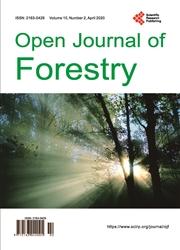Factors Influencing Community Participation in Forestry Management in Chiradzulu District, Malawi
引用次数: 0
Abstract
Community participation in forestry management is a good approach to pro-tecting forests and woodlands. This study was carried out to assess factors affecting community participation in forestry management in Chiradzulu Dis-trict. The study employed a mixed-method approach where qualitative and quantitative data were collected. Results showed that there is an almost equal percentage of female and male respondents who participated in forestry management. The Logit model analysis shows that education variables are positive and statistically significant proving that education influences participation in forestry management and hence education is an important variable in determining households’ participation in forestry. Only the age group of 45 - 59 years was significant but had a negative coefficient with a moderate marginal effect at 59% (r = 0.59) implying that many people in this age group participated in forestry activities than other age groups. When the size of household land ownership was used as a proxy to indicate household wealth and then correlated with participation in forestry activities, a positive and significant correlation between households that owned 1 - 2 acres and 3 - 5 acres of land and their participation in forestry activities was observed. It can be concluded that the size of land owned is one of the key factors that determine households’ participation in forestry management. Furthermore, a connection between land size distribution and effects on environmental resources was evident.马拉维Chiradzulu地区影响社区参与林业管理的因素
社区参与森林管理是保护森林和林地的一个好办法。本研究旨在评估影响奇拉祖鲁县社区参与林业管理的因素。该研究采用了混合方法,收集了定性和定量数据。结果表明,参与林业管理的女性和男性受访者的比例几乎相等。Logit模型分析显示,教育变量为正,且具有统计学显著性,证明教育影响林业经营参与,因此教育是决定家庭林业参与的重要变量。只有45 - 59岁年龄组显著,但有一个负系数,中等边际效应为59% (r = 0.59),这意味着这个年龄组参加林业活动的人数比其他年龄组多。当以家庭土地所有权大小作为家庭财富的代表,然后将其与林业活动的参与相关时,发现拥有1 - 2英亩土地和3 - 5英亩土地的家庭与林业活动的参与之间存在显著的正相关。结果表明,土地面积是决定农户参与林业经营的关键因素之一。此外,土地面积分布与对环境资源的影响之间存在明显的联系。
本文章由计算机程序翻译,如有差异,请以英文原文为准。
求助全文
约1分钟内获得全文
求助全文

 求助内容:
求助内容: 应助结果提醒方式:
应助结果提醒方式:


